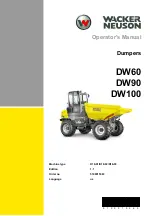
SAFE OPERATION
4
1. Observe all regulations concerning the transport of
excavators on public roads.
2. Use adequately long and robust ramps when loading
on a vehicle. (for details see "TRANSPORTING THE
EXCAVATOR ON A VEHICLE")
3. Do not change the running direction and to avoid a
tipping over, do not try to swing the attachment
crosswise to the loading ramps.
4. Lower the attachment on the loading plane and
release the pressure from the hydraulic system.
Block the tracks with blocks and tie down the
excavator. After loading the excavator on the vehicle,
securely tie down the undercarriage of the excavator
using suitable chains, tensioners and approved
methods.
5. Avoid abrupt braking of the vehicle with the excavator
loaded. The excavator may shift causing on accident.
6. If the excavator is to tow another machine, make sure
the load is smaller than the strength of the hook, tow
chain or cable.
7. Do not use hooks on the roof of canopy or cabin for
lifting the excavator.
Before doing maintenance work on the excavator, place
the machine on even solid ground, lower the attachments
to the ground, stop the engine , release pressure trapped
in the hydraulic system and remove the key. When
dismantling hydraulic parts, make sure that the hydraulic
oil has cooled down sufficiently to avoid burns.
Start maintenance work carefully, e.g. loosen plug slowly
so that oil will not squirt out.
1. Before doing work on the engine, the exhaust system,
the radiator and the hydraulics, let the excavator cool
down sufficiently.
2. Turn off the engine at all times when filling with fuel.
Avoid spilling and over-filling of fuel.
3. Smoking is prohibited while refueling or handling the
battery! Keep sparks and fire away from the fuel tank
and battery. Flammable gases escape from the
battery, especially during charging.
4. Do not use or charge the refillable type battery if the
fluid level is below the LOWER (lower limit level) mark.
Otherwise, the battery component parts may be
prematurely deteriorated, which may shorten the
battery's service life or cause an explosion. Check the
fluid level regularly and add distilled water as required
so that the fluid level is between the UPPER and
LOWER levels.
5. Read and follow the directions "STARTING WITH AN
AUXILIARY BATTERY" in "OPERATION OF THE
ENGINE", when starting with an auxiliary battery.
6. Keep a first-aid box and a fire extinguisher at hand at
all times.
7. Do not open the radiator cap before the radiator has
cooled down sufficiently
First loosen the cap to the first stop and allow the
system enough time to release the remaining
pressure. Then loosen the cap completely.
8. To avoid short-circuiting the battery, always remove
the ground cable first and attach the plus cable first.
9. Leaking hydraulic fluid has enough pressure to
penetrate the skin and cause serious injuries.
Leakages from pin holes can be totally invisible. Do
not use hands for checking for leaks. Always use a
piece of wood or cardboard. It is strongly
recommended to use a face mask or eye protection.
Should injuries occur with leaking hydraulic fluid,
contact a doctor immediately. This fluid can cause
gangrene or serious allergic reactions.
4.
SAFE LOADING AND TRANSPORT OF
THE EXCAVATOR
Max. drawbar pull at
coupling hook
70450 N (7183 kgf)
Max. vertical load at
coupling hook
7210 N (735 kgf)
5. MAINTENANCE
Summary of Contents for Super Series 2 KX 91-3
Page 14: ...SAFE OPERATION 6 6 DANGER WARNING AND CAUTION LABELS...
Page 15: ...7 SAFE OPERATION...
Page 16: ...SAFE OPERATION 8...
Page 17: ...9 SAFE OPERATION...
Page 18: ...SAFE OPERATION 10...
Page 19: ...11 SAFE OPERATION...
Page 20: ...SAFE OPERATION 12...
Page 95: ...75 LIFTING CAPACITY...
Page 96: ...76 LIFTING CAPACITY...
Page 97: ...77 LIFTING CAPACITY...
Page 98: ...78 LIFTING CAPACITY...






























